In the era of e-commerce and make-to-order (MTO) manufacturing, customer purchase behavior has a pronounced impact on the manufacturer’s production process. Many customers prefer more personalized products that satisfy their specific needs, while others are unwilling to wait long for customized products and prefer standard products on a guaranteed order delivery time. Such diverse customer purchase behaviors require the production process to be flexible while ensuring its productivity[1]. Consequently, the postponement strategy is adopted to match the various behaviors.
In practice, many assembly industries, such as electronics and automobile, have adopted the postponement strategy. Investment on standardization, modular design, and process restructuring are three product/process redesign approaches commonly applied to the postponement[2]. For example, Helmut Schramm, head of BMWi production, claims that it costs BMW around ![]() 400 million ($552 million) for the process investment at its plant in Leipzig, Germany[3]. BMW made an investment in parallel assembly of the Life module and the Drive module before the two modules were integrated into the LifeDrive architecture. As a result, the true appearance of the cars emerged only at final assembly rather than in the body shop. Hewlett-Packard (HP) created the so-called design for localization[4]. HP redesigned their products so that the power supply module was the last component to be added. This addition can be easily done at the distribution center. With the above highlighted benefit of delayed product differentiation, it is thus important to have the analytics ability to make an optimal investment decision about necessary process improvement for achieving such delayed product differentiation.
400 million ($552 million) for the process investment at its plant in Leipzig, Germany[3]. BMW made an investment in parallel assembly of the Life module and the Drive module before the two modules were integrated into the LifeDrive architecture. As a result, the true appearance of the cars emerged only at final assembly rather than in the body shop. Hewlett-Packard (HP) created the so-called design for localization[4]. HP redesigned their products so that the power supply module was the last component to be added. This addition can be easily done at the distribution center. With the above highlighted benefit of delayed product differentiation, it is thus important to have the analytics ability to make an optimal investment decision about necessary process improvement for achieving such delayed product differentiation.
The postponement production system is usually composed of two phases, namely, push and pull. On the one hand, the push phase is forecast-driven. It is located upstream and follows standard production. On the other hand, the pull phase is customer-driven. It is located downstream and follows customized production. The order penetration point (OPP) is the boundary between these two phases, which is also known as the point of differentiation or the customer order decoupling point. Given the importance of the postponement strategy, the OPP decision problem has attracted much attention in the literature.
There are two main lines of literature related to our study, i.e., OPP decision-making with and without consideration of any process improvement. We first review the literature without considering any process improvement. Jewkes et al.[5] found that the optimal OPP moves downstream if customers accept a narrower range of product characteristics. However, the optimal OPP is neither sensitive to the changes in supplier capacity nor customer demand. Pang et al.[6] proposed a cost control model with multiple product differentiation points, and analyzed the implementation conditions of process flow reorder. Zhang et al.[7] presented a supply chain postponement strategy model by using the queuing theory to determine the optimal ratio of differentiation and inventory level. Shao et al.[8] modeled various postponement strategies for coping with risk in the thin film transistor liquid crystal display industry. Shan et al.[9] investigated the application of the postponement strategy in apparel supply chain management. They found that it is beneficial to adjust the first production proportion and replenishment ratio to improve competitiveness. Liu et al.[10] proposed an OPP decision model considering time scheduling with capacity and time constraints. Numerical examples showed that OPP moves earlier with the increase in the volume of new orders. Yousself et al.[11] studied the impact of items priority levels on the optimal MTO/MTS decisions. By setting the optimal priority allocation and the base-stock levels, the overall inventory costs are minimized. Nevertheless, the studies discussed above only explored the relationship between the optimal OPP and the postponement strategy. Little investigation has been done on the relationship between OPP and the investment process.
The literature on the impact of process improvement on the OPP decision-making is still in its infancy. Lee[12] was the first to present inventory models for product/process design applications. Those models, however, assume that no buffer stocks are held until the end of the production process. In a further developed model, Lee et al.[2] allowed different process points to hold inventories and incorporated several factors that would normally be affected by delayed product differentiation. However, the average investment cost per period is independent of OPP in their model. Su et al.[13] considered the problem that a firm can make a series of investments to design generic product components with the implementation of postponement structure. However, the one-time investment cost is assumed to be fixed in their model. More recently, Ngniatedema et al.[14] extended the model[2] by incorporating the delivery of product components from an external supplier at the beginning of the production network. However, the investment cost remains independent of OPP.
In our paper,OPP can be pushed downstream through process investment. We model the production process to better understand how the investment level affects the trade-off between customer order fulfillment delay and inventory risks. We use an approach similar to that proposed by Jewkes et al.[5] and propose an alternative model. First, our model is used to investigate the impact of the investment level on the postponement strategy instead of market characteristics[5]. Secondly, the investment level is regarded as a decision variable in our model, not a fixed value. In addition, we assume that the updated OPP through process improvement meets the law of diminishing marginal utility, and thus it is modeled with a continuous, increasing, and concave function with respect to the investment level.
1 Production System Model
For each type of product that the manufacturer offers, the production system consists of two phases. In phase one, the semi-finished parts are made in an MTS fashion, and are stocked at the warehouse. In phase two, when the manufacturer receives customer orders, the semi-finished parts are customized in an MTO fashion and are sent directly to customers. Fig.1 illustrates the postponement production process.
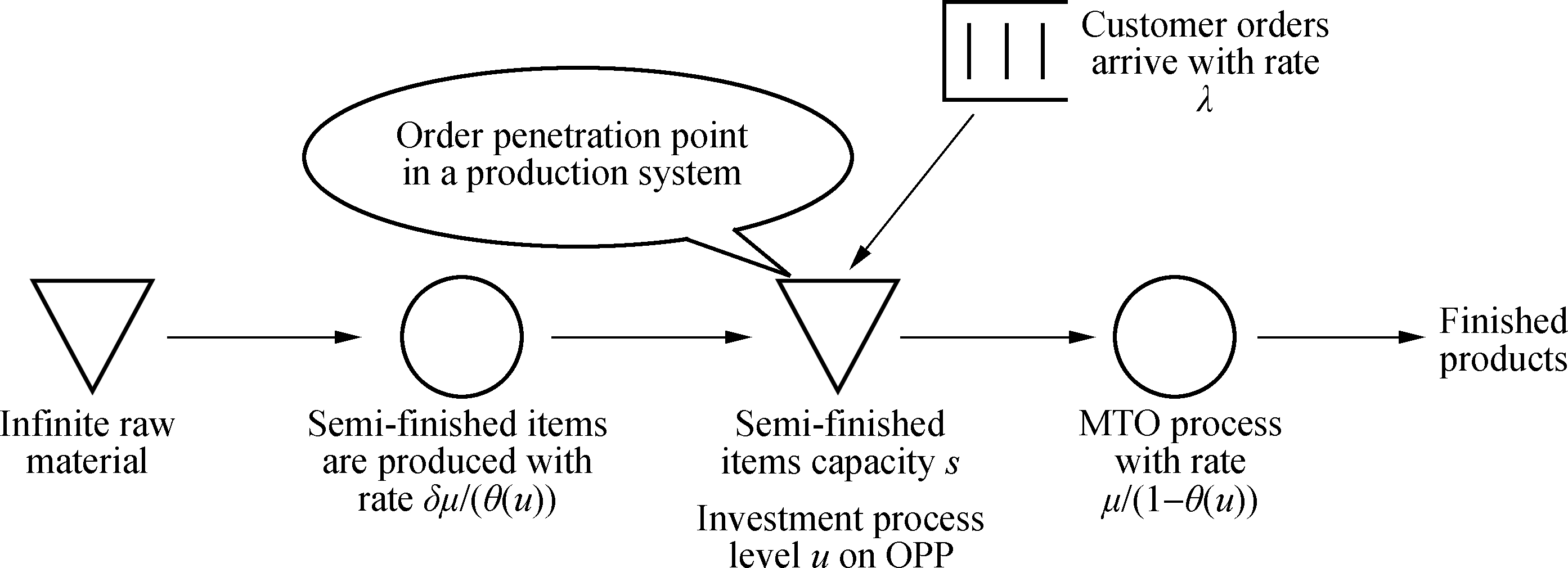
Fig.1 The postponement production process
As shown in Fig.1, we assume that the manufacturer can procure an infinite amount of raw materials and never faces shortages. Meanwhile, we assume that it has limited storage capacity for semi-finished products, denoted by s. We quantify the OPP variable, denoted by θ(0<θ<1), to be the percentage of product completion after phase one. We set θ0 to be the initial OPP. Note that we use θ, a continuous variable, to quantify the decision about product differentiation, thus it is more convenient to derive analytical results from our model and conduct sensitivity analyses. While most of the production processes are not continuous with respect to OPP, the optimal value obtained from our model can be used in practice to guide the postponement of product differentiation.
We denote u to be the level of investment on process improvement (u≥0). θ(u) represents the new OPP that resulted from the process improvement with investment level u. Assume that θ(·) satisfies θ(0)=θ0, ![]() θ′(u)>0, θ″(u)<0. Additionally, we assume that orders are processed with a mean rate μ. We assume the time taken at phase one to produce one unit of semi-finished product to be exponentially distributed with parameter
θ′(u)>0, θ″(u)<0. Additionally, we assume that orders are processed with a mean rate μ. We assume the time taken at phase one to produce one unit of semi-finished product to be exponentially distributed with parameter ![]() where δ>0 is the scaling factor representing the ratio of MTS processing rate to the MTO processing rate. We also assume that the time taken at phase two to process one unit of semi-finished product is exponentially distributed with parameter
where δ>0 is the scaling factor representing the ratio of MTS processing rate to the MTO processing rate. We also assume that the time taken at phase two to process one unit of semi-finished product is exponentially distributed with parameter ![]() Next, we assume that customer orders arrive according to a Poisson process with rate λ and they are served on a first-come-first-served (FCFS) basis. Once the products are retrieved and processed, we can fulfill the customer orders.
Next, we assume that customer orders arrive according to a Poisson process with rate λ and they are served on a first-come-first-served (FCFS) basis. Once the products are retrieved and processed, we can fulfill the customer orders.
1.1 Markov model
With the above system specifications, we model the order fulfillment process as a continuous-time Markov chain with infinite states. The state space is {(i,j),i≥0,0≤j≤s}, where i is the number of orders and j is the number of semi-finished products. Fig.2 presents the transition diagram with row and column indices by i and j. We next explain representative states and state transitions. State (0, 0) implies an idle system. When a customer’s order is placed, the system state changes from (0, 0) to (1, 0) with transition rate λ. After completing the first phase of the manufacturing system, the system state changes to (1, 1) with transition rate ![]() After the order is fulfilled, the system state returns to (0, 0) with rate
After the order is fulfilled, the system state returns to (0, 0) with rate ![]()

Fig.2 Transition rate diagram of the Markov chain
Let π={π0,π1,…,πn} be the steady-state probability of the Markov chain, where πn={π(n,0),π(n,1),…,π(n,s)} is an (s+1)-dimensional row vector. Additionally, π(i,j) denotes the steady-state probability associated with the condition that there are i orders and j semi-finished products. Referring to the transition diagram in Fig.2, we obtain the following balance equations:
(a+λ)π(i,j)=bπ(i+1,j+1) i=0,j=0
(1)
(a+λ)π(i,j)=aπ(i,j-1)+bπ(i+1,j+1) i=0,1≤j≤s-1
(2)
λπ(i,j)=aπ(i,j-1) i=0,j=s
(3)
(a+λ)π(i,j)=λπ(i-1,j)+bπ(i+1,j+1) 1≤i,j=0
(4)
(a+λ+b)π(i,j)=aπ(i,j-1)+λπ(i-1,j)+bπ(i+1,j+1)
1≤i,1≤j≤s-1
(5)
(λ+b)π(i,j)=aπ(i,j-1)+λπ(i-1,j) 1≤i,j=s
(6)
The generator matrix of the Markov chain is given by

(7)
where


1.2 Performance evaluation
Before analyzing the steady states, we check the stability condition inherent to the Markov chain modeled earlier. We introduce matrix A=A0+A1+A2, where A is a generator matrix and its associated stationary distribution X={X0,X1,X2,…,Xs} is a solution to XA=0 and ![]() Considering
Considering ![]() we obtain
we obtain ![]() {α0,α1,α2,α3,…,αs}.
{α0,α1,α2,α3,…,αs}.
To ensure the stability of the system, the processing rate for the second phase of the production must be greater than the customer arrival rate and smaller than the processing rate for the first phase. Moreover, the Markov chain is positively recurrent if the following condition is met: XA2D>XA0D. D is an (s+1)-dimentional row vector of which the entries are 1. Thus, we obtain the stability condition as ![]() Once the Markov chain is shown to be stable, we can derive the steady-state distribution.
Once the Markov chain is shown to be stable, we can derive the steady-state distribution.
To compute the steady-state distribution, we employ the matrix geometric method (MGM), which is effective when dealing with high-dimensional systems[15]. We use the submatrices of Q to compute the steady-state probability vector iteratively, with boundary vector π0 determined by π0(B+RA2)=0. The rate matrix R is introduced, which satisfies the matrix geometric equation: πi+1=πiR, i≥0. Moreover, R is the minimal non-negative solution to the matrix quadratic equation: A0+RA1+R2A2=0. That is, R is determined by the submatrices of the repeating portion in Q. One way to compute R numerically follows an iterative approach: ![]() , until |R(n+1)-R(n)|(i,j)<ε, with R(0)=0. It is known that the spectral radius of R is less than one if the Markov chain is stable and ergodic.
, until |R(n+1)-R(n)|(i,j)<ε, with R(0)=0. It is known that the spectral radius of R is less than one if the Markov chain is stable and ergodic.
With the steady-state distribution, we can compute the following queuing performance measures: E(L) is the expected number of customer orders; E(W) is the expected customer order fulfillment delay (i.e., the expected time from customer order arrival to order completion), and E(O) is the expected number of semi-finished products. The measures are then given by
E(L)=π1(I-R)-2D
E(W)=E(L)/λ
E(O)=π0(I-R)-1V, V={0,1,2,…,s}T
We next present a stylistic numerical example to illustrate how the investment level u and the initial OPP θ0 affect E(W) and E(O). Set θ0 to be 0.1, 0.3 and 0.6. Recall that θ(0)=θ0, ![]() θ′(u)>0, θ″(u)<0. We consider two functions to represent θ(u) that satisfy the above conditions. The two functions are
θ′(u)>0, θ″(u)<0. We consider two functions to represent θ(u) that satisfy the above conditions. The two functions are ![]() and
and ![]() shown in Fig.3. Other parameters are as follows: λ=0.55, s=3,
shown in Fig.3. Other parameters are as follows: λ=0.55, s=3, ![]() ε=10-100, c=0.07 and γ=0.3. We assume that δ=θ(u). Figs.3(a) to 5(a) report the cases for θ1(u) and Figs.3(b) to 5(b) report the cases for θ2(u).
ε=10-100, c=0.07 and γ=0.3. We assume that δ=θ(u). Figs.3(a) to 5(a) report the cases for θ1(u) and Figs.3(b) to 5(b) report the cases for θ2(u).
From Fig.4, we observe that a higher investment level results in a shorter expected customer order fulfillment delay. This observation implies that a smaller percentage of the production process is required to perform the customization task, which reduces the expected customer order fulfillment delay. Additionally, E(W) is sensitive to θ0. If the initial OPP is located at the front-end of the production process, the expected fulfillment delay registers a more marked reduction. However, when the process improvement is beyond a certain investment level, such as u=10 in Fig.4(a), the expected customer order fulfillment delay remains unchanged, no matter where the initial OPP is located.
Fig.5 shows how E(O) is affected by u. A higher investment level is beneficial to hold a fewer expected number of semi-finished products. As the investment level increases, the initial OPP is pushed down; i.e., a larger
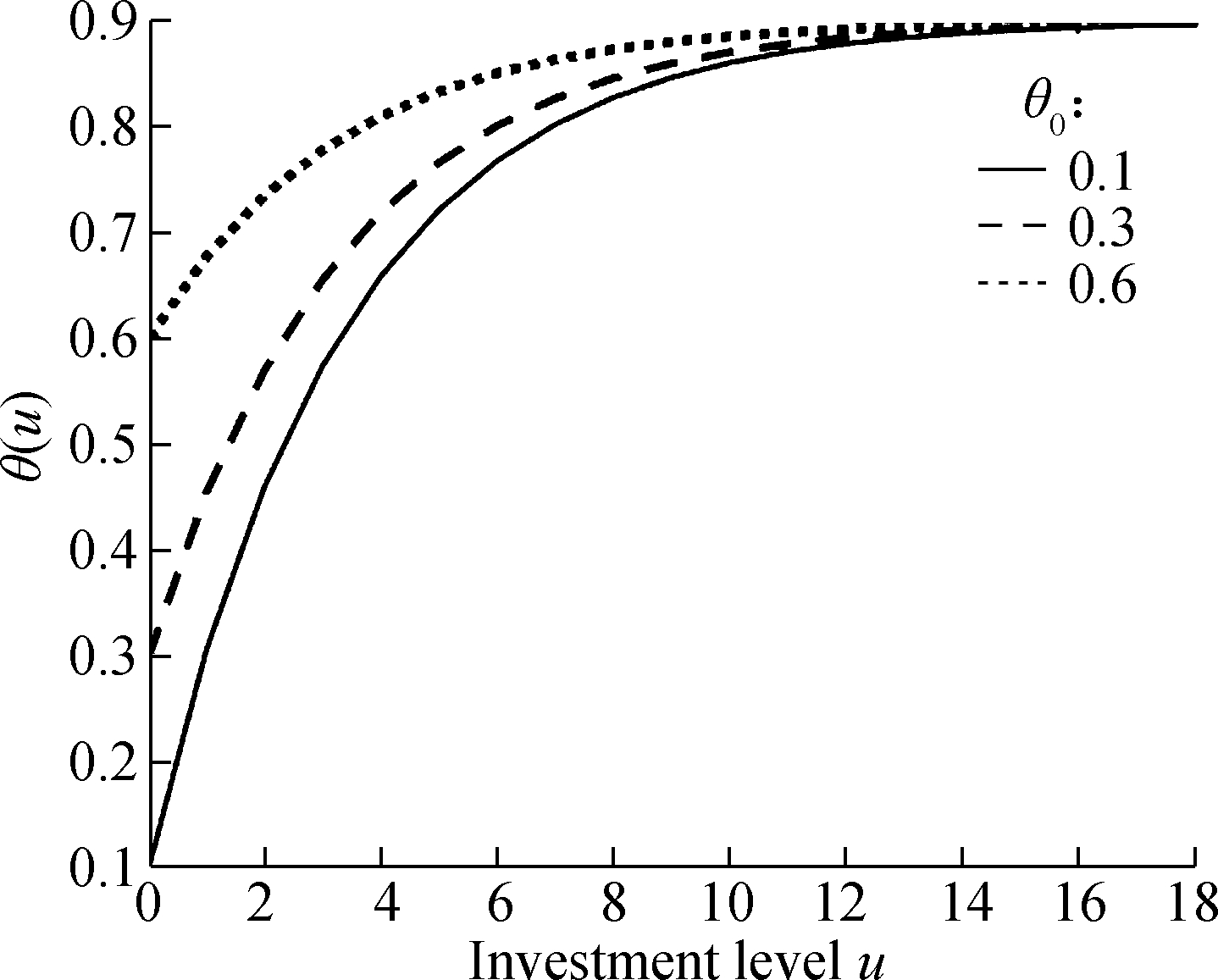
(a)
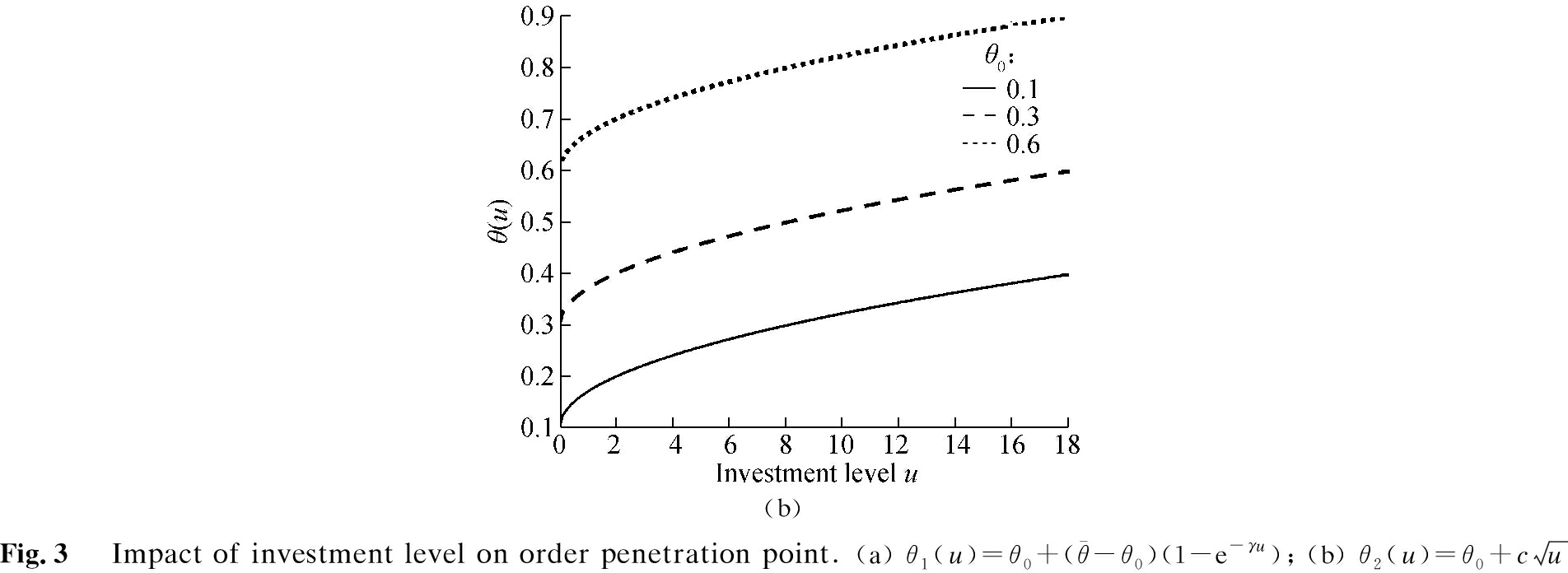
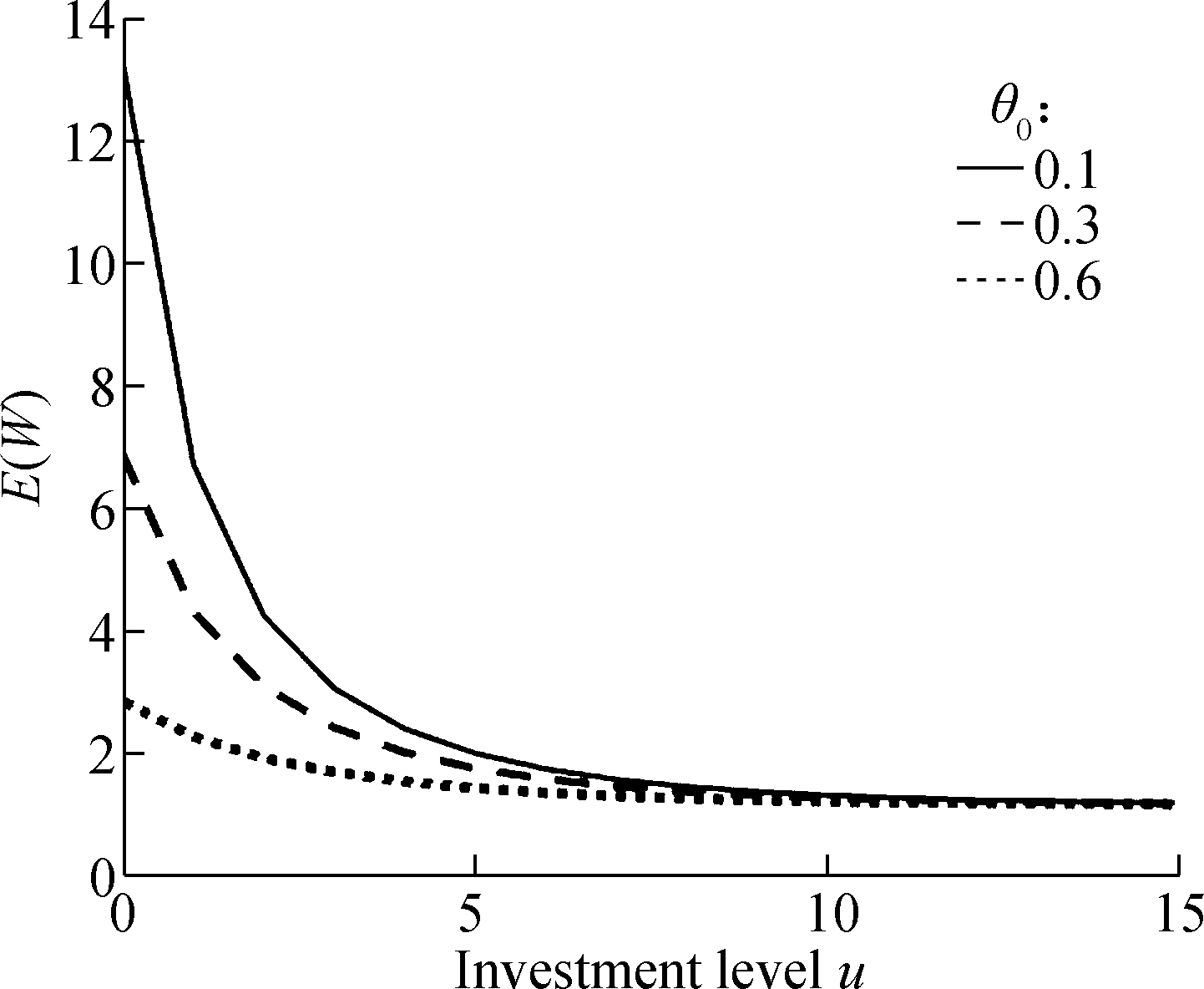
(a)

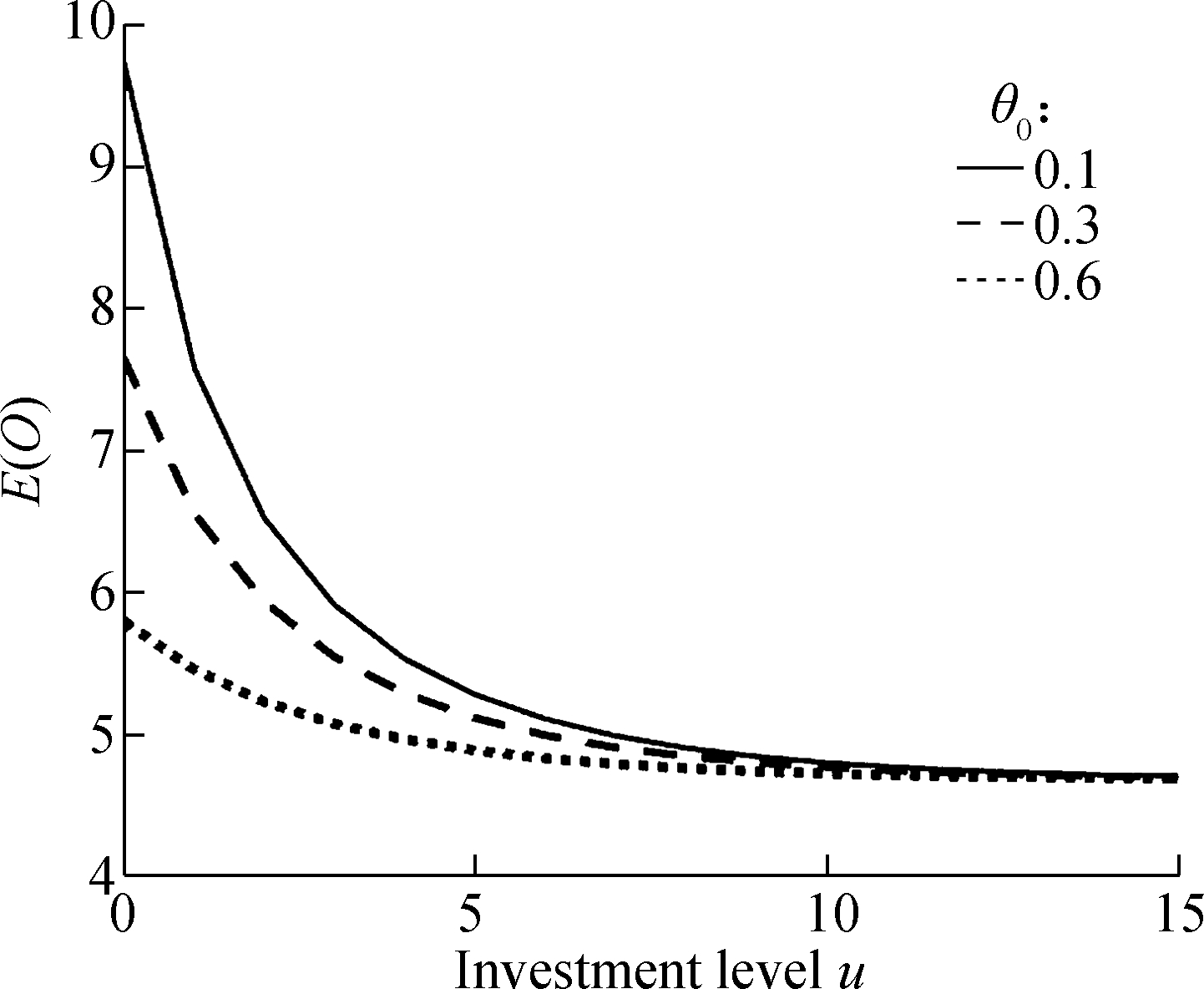
(a)
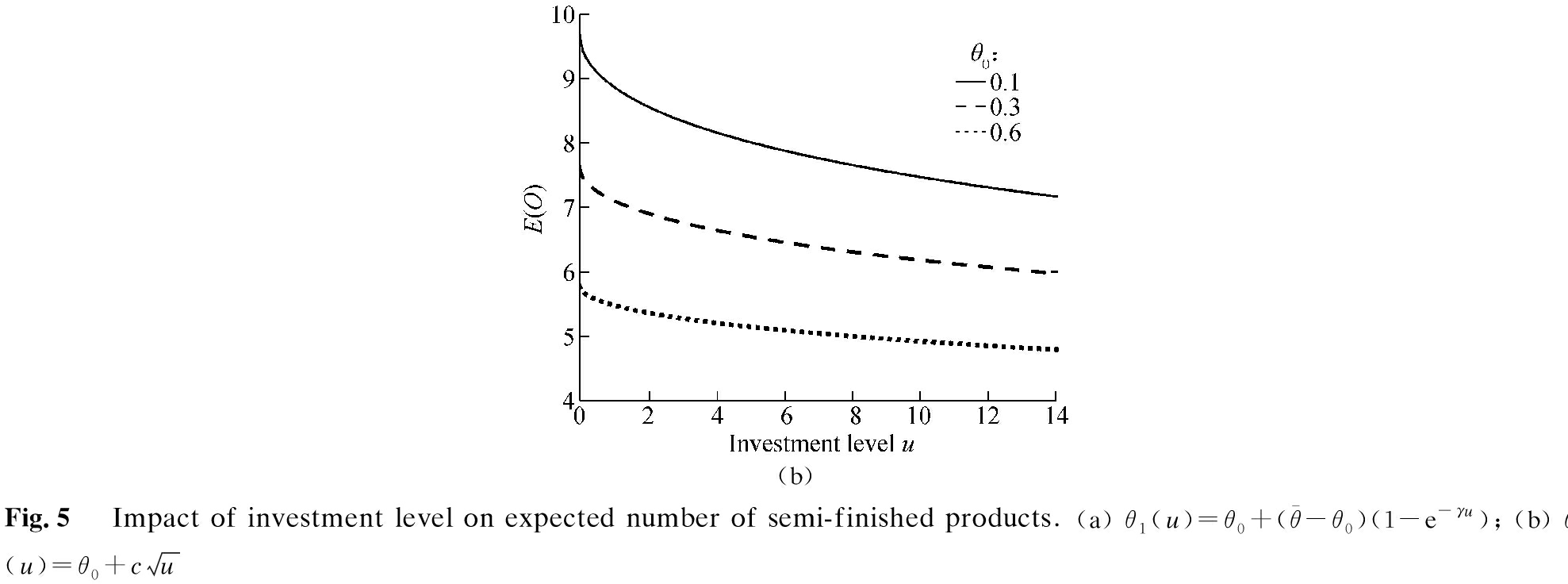
percentage of each product is completed in advance in phase one. Customers can receive their products much faster. As a result, it is not necessary to hold a more semi-finished products inventory. Similarly to Fig.4, E(O) is also sensitive to θ0. The smaller the θ0, the larger the E(O).
2 Cost-Minimization Formulation
The manufacturer seeks to minimize the sum of the following costs when determining the optimal investment level u*: The expected cost of customer order fulfillment delay; the expected inventory holding cost of semi-finished products; and process improvement cost. Mathematically speaking, the manufacturer intends to minimize its total cost (TC).
minTC(u)=CwE(W)+ChV(θ)E(O)+gu2
(8)
where Cw is the average cost per time unit of customer order fulfillment delay; Ch is the average holding cost per time unit per semi-finished product; V(θ) is the average value per semi-finished product, assumed to be increasing in θ; and g is the cost coefficient of the investment. Here we assume that the cost directly associated with the investment level is quadratically proportional to the investment level. The customer order fulfillment delay may decrease as the investment level increases. However, an increased investment may also increase the inventory holding cost of semi-finished products and also increase spending on the investment. Hence, the manufacturer must weigh these conflicting factors when selecting the optimal investment level.
2.1 Optimization results
We present numerical experiments to investigate how the manufacturer’s total cost is affected by the initial OPP and the investment level. In these experiments, we use ![]() In our Matlab R2015a implementation, we used the following parameter values: λ=0.55, μ=1, s=3,
In our Matlab R2015a implementation, we used the following parameter values: λ=0.55, μ=1, s=3, ![]() ε=10-100, Cw=1, Ch=1, γ=0.3 and g=0.1. We assumed that δ=θ(u) and V(θ)=Vθ(u), where V is the value of the product and equal to 1. Since both E(W) and E(O) are unchanged when u≥10, as shown in Fig.4(a) and Fig.5(a), we use the enumeration method to calculate TC by selecting the value of u from 0 to 10.
ε=10-100, Cw=1, Ch=1, γ=0.3 and g=0.1. We assumed that δ=θ(u) and V(θ)=Vθ(u), where V is the value of the product and equal to 1. Since both E(W) and E(O) are unchanged when u≥10, as shown in Fig.4(a) and Fig.5(a), we use the enumeration method to calculate TC by selecting the value of u from 0 to 10.
Fig.6 shows the manufacturer’s total cost and the OPP under different investment levels when θ0=0.1. It is noted that the minimum total cost is 7.361 and it occurs when the investment level is 3, i.e., u*=3. The manufacturer’s total cost is reduced by 48.29% through process investment, which is remarkable. The corresponding optimal OPP θ(u*) is 0.575. Increasing the investment level can indeed lower the manufacturer’s total cost. However, when the investment level further increases, it no longer results in any cost reduction.
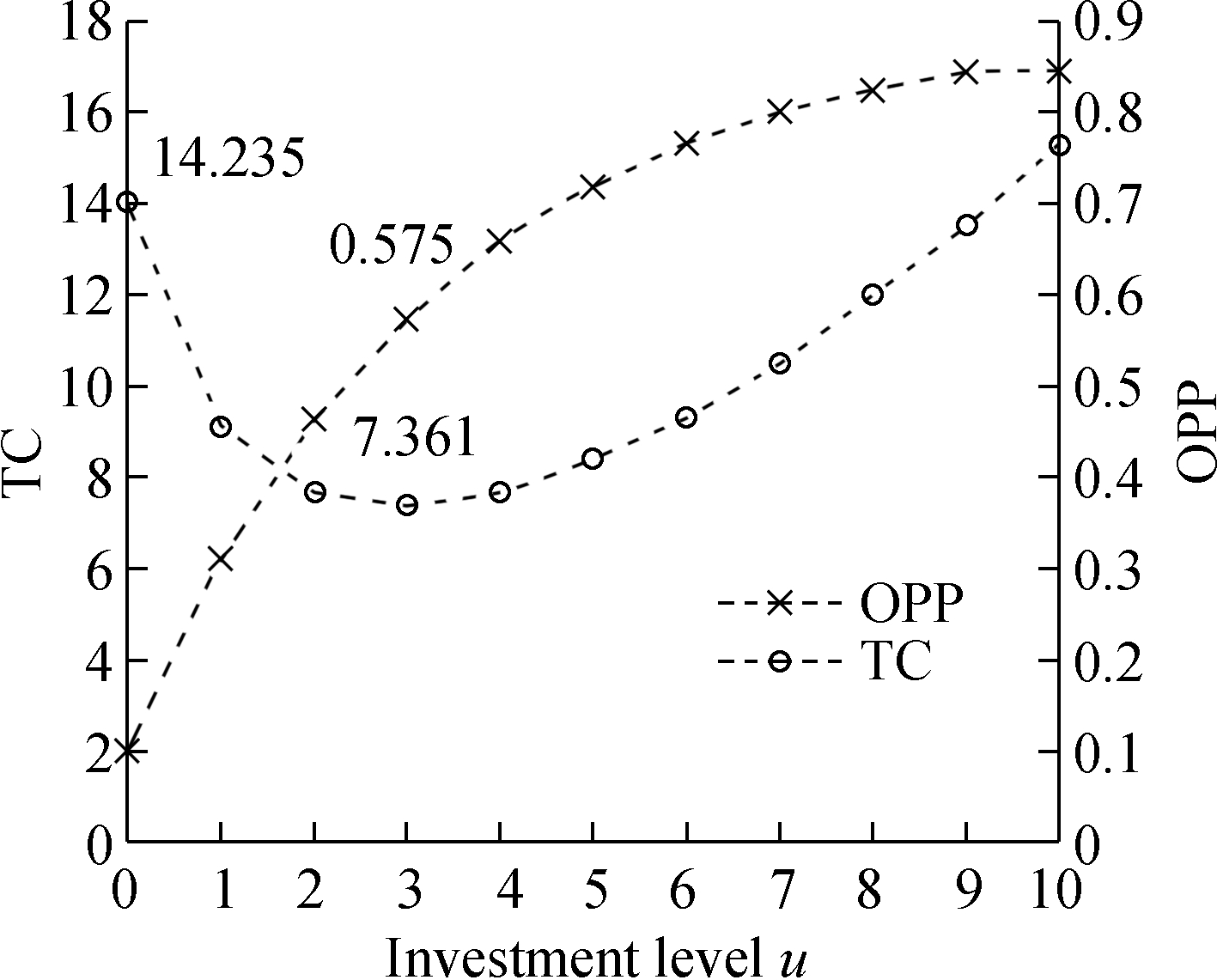
Fig.6 Impact of investment level on total cost and OPP
Tab.1 shows the optimal investment level u* and the optimal OPP θ(u*) with respect to varied θ0. As θ0 increases, u* decreases and is greater than 0. Thus, it is beneficial to further delay product differentiation through process investment, since reducing the customer order fulfillment delay is the primary goal of the manufacturer. However, when θ0=0.8, u* is reduced to 0. It means that there is no investment. The manufacturer’s total cost increases in response to any further increase in investment, and thus the manufacturer is unwilling to further invest in the process improvement. On the other hand, the optimal OPP θ(u*) does not strictly increase with θ0. θ(u*) declines from 0.615 to 0.571 when θ0 increases from 0.2 to 0.3. The reason is that u* decreases from 3 to 2. For a similar reason, θ(u*) falls slightly when θ0 increases from 0.5 to 0.6. Fig.7 describes the relationship among θ(u*), u* and θ0.
Tab.1 The optimal decisions for various θ0
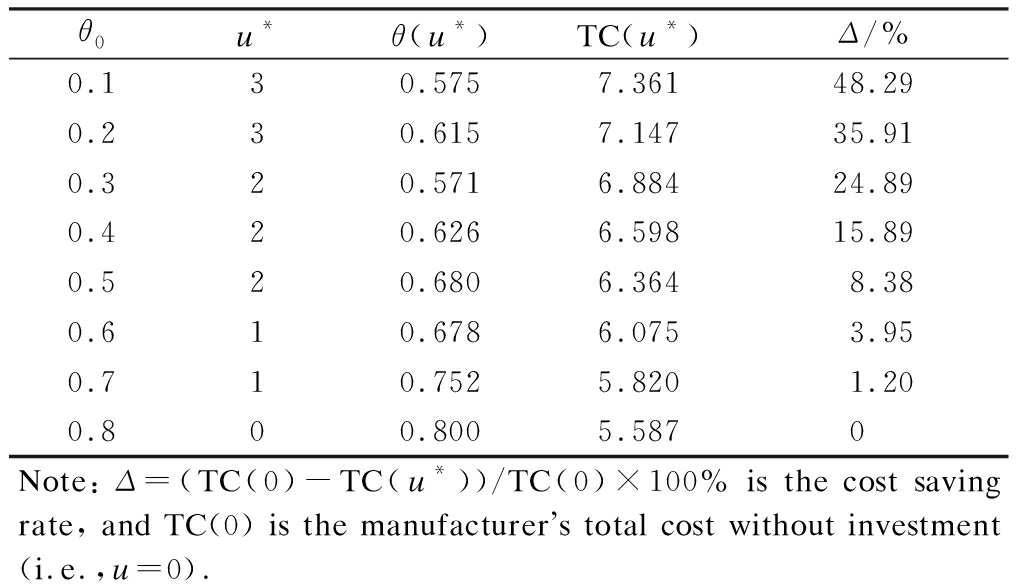
θ0u*θ(u*)TC(u*)Δ/%0.130.5757.36148.290.230.6157.14735.910.320.5716.88424.890.420.6266.59815.890.520.6806.3648.380.610.6786.0753.950.710.7525.8201.200.800.8005.5870Note: Δ=(TC(0)-TC(u*))/TC(0)×100% is the cost saving rate, and TC(0) is the manufacturers total cost without investment (i.e.,u=0).
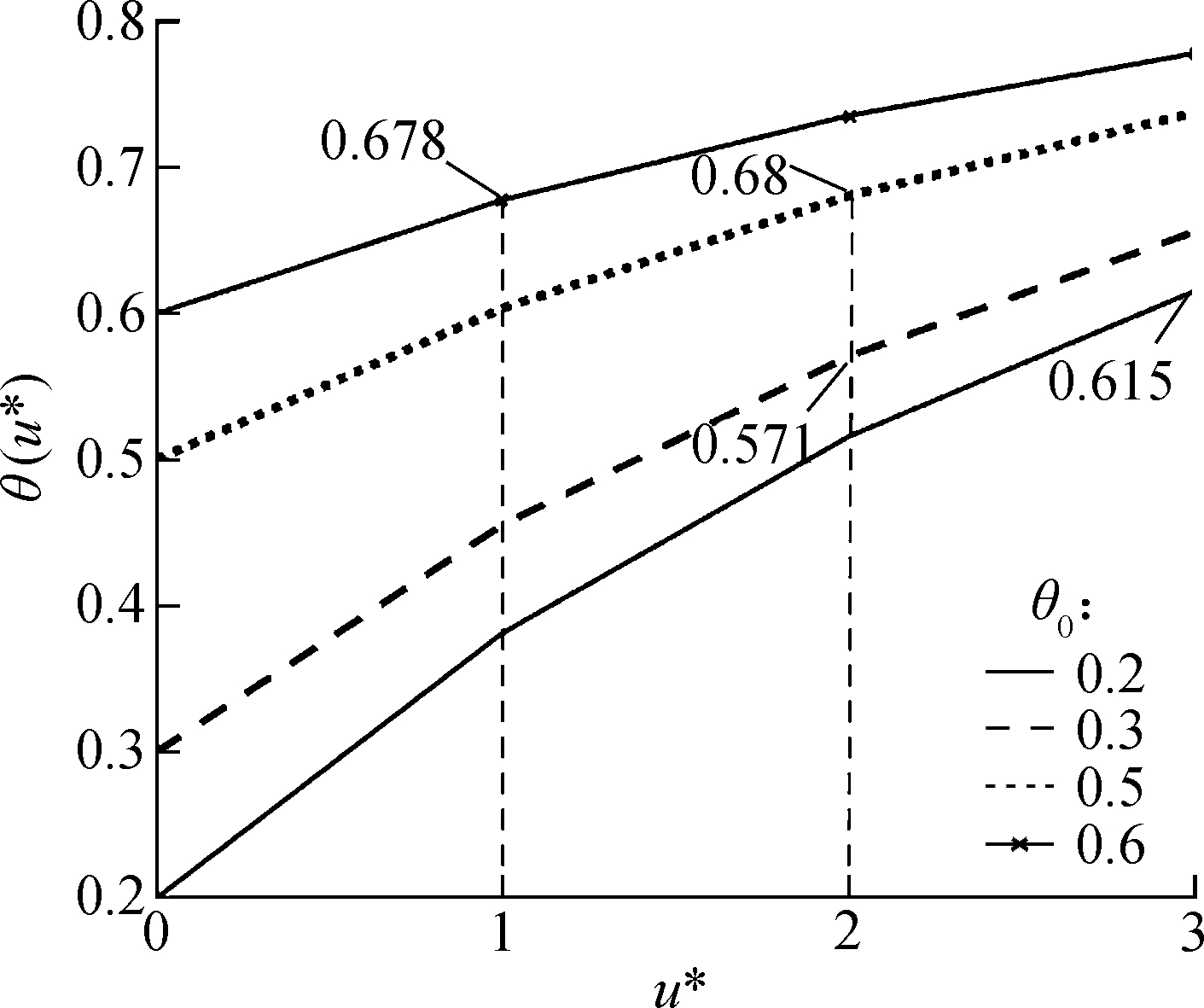
Fig.7 The optimal OPP and optimal investment level under different θ0
2.2 Sensitivity study
Next, we study the sensitivity of optimal solutions with the parameters changing.
Fig.8(a) and Fig.9(a) illustrate that as the unit-time cost of customer order fulfillment delay increases, the optimal investment level and the cost saving rate increase. This implies that, for a higher unit-time cost of customer order fulfillment delay, the manufacturer should more sensibly consider an investment in the process improvement. In other words, the OPP is likely to be further pushed downstream with impatient customers.
As the product value increases in Fig.8(b) and Fig.9(b), the optimal investment level and the cost saving rate decrease. This implies that the manufacturer is less willing to make an investment on process improvement when the product value becomes larger. This is due to an increase in the holding cost of the semi-finished products.
Additionally,as shown in Fig.8(c) and Fig.9(c), the optimal investment level and the cost saving rate decrease with the increase in the cost coefficient of the investment. A higher cost coefficient of the investment means that the manufacturer should invest more in order to achieve the same delivery lead time. To balance the customer order fulfillment delay cost with the investment cost, the manufacturer may set a reasonable investment level.
For more sensitive information, please see Tabs.2 to 4.

(a) 
(b)  (c)
(c)
Fig.8 Impact of Cw, V, g, θ0 on optimal investment level.
(a) V=1, g=0.1; (b) Cw=1,g=0.1; (c) Cw=1,V=1

(a) 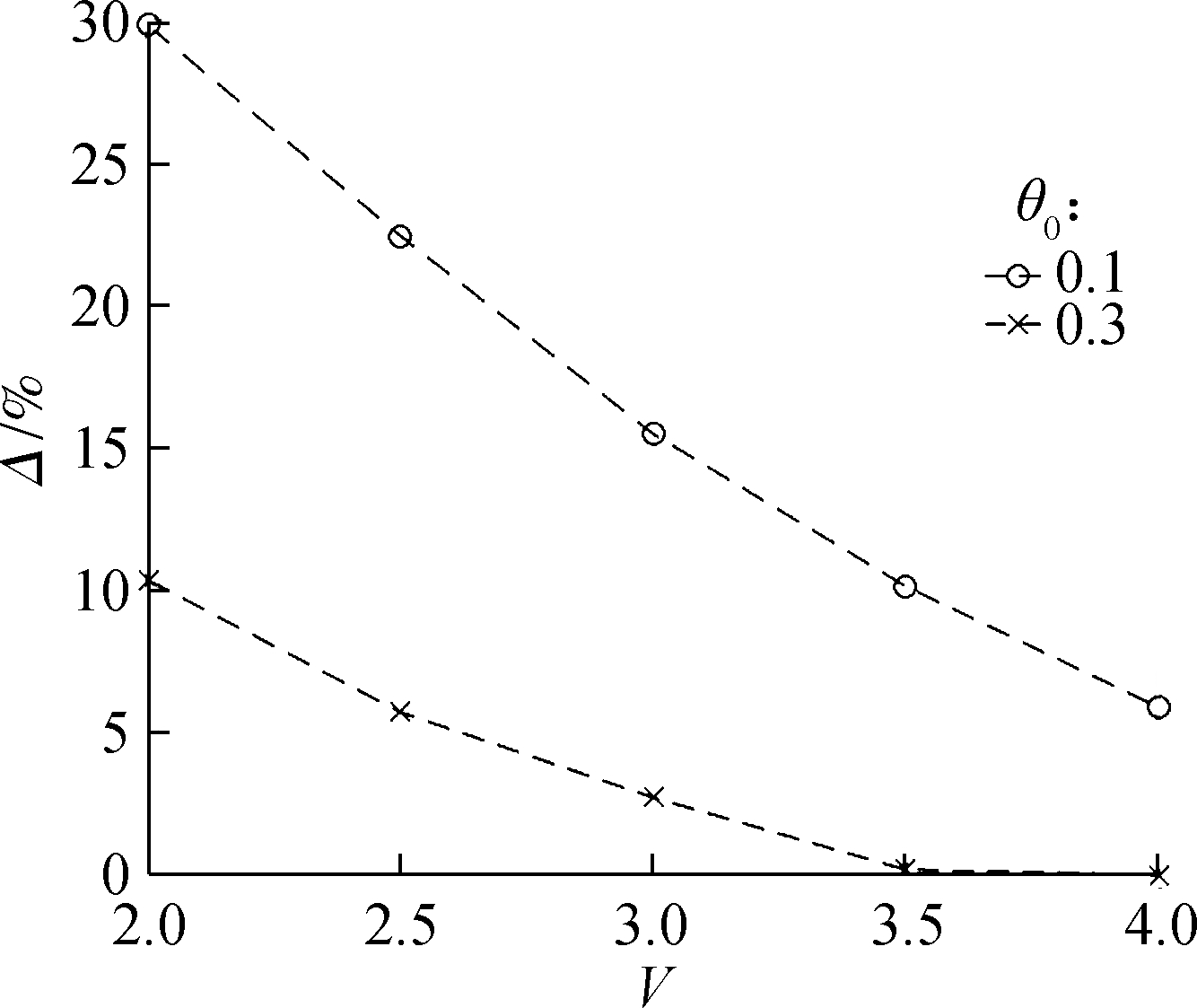
(b)  (c)
(c)
Fig.9 Impact of Cw, V, g, θ0 on cost saving rate.
(a) V=1, g=0.1; (b) Cw=1,g=0.1; (c) Cw=1,V=1
Tab.2 The optimal u* and TC(u*) for various Cw

θ0u*Cw=1.5Cw=2Cw=2.5TC(u*)Cw=1.5Cw=2Cw=2.50.14448.85110.05211.2540.23448.5099.73310.8340.33348.1749.38610.4490.43347.8808.95710.0970.52337.4938.5779.5340.62227.1338.0959.0570.71226.7377.6478.4640.81116.3587.0917.825
Tab.3 The optimal u* and TC(u*) for various V
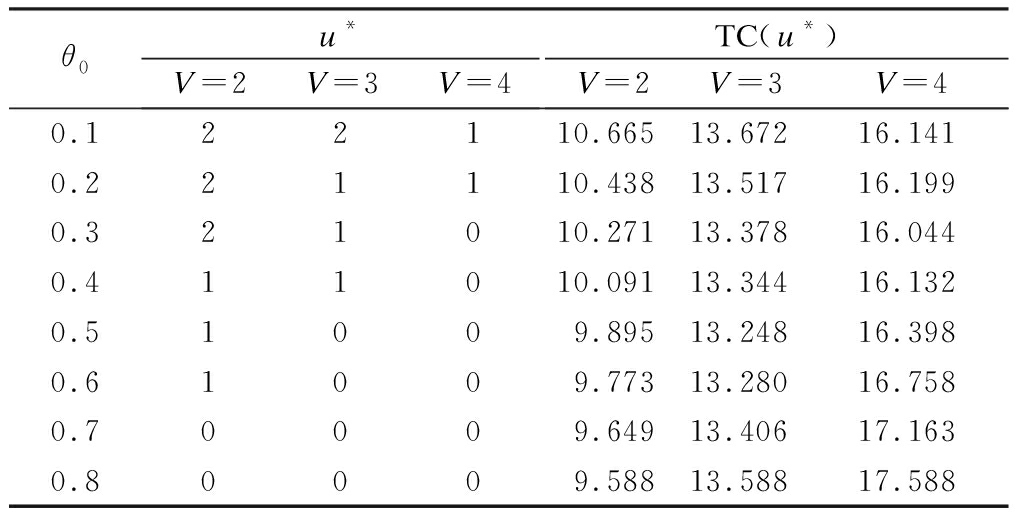
θ0u*V=2V=3V=4TC(u*)V=2V=3V=40.122110.66513.67216.1410.221110.43813.51716.1990.321010.27113.37816.0440.411010.09113.34416.1320.51009.89513.24816.3980.61009.77313.28016.7580.70009.64913.40617.1630.80009.58813.58817.588
Tab.4 The optimal u* and TC(u*) for various g
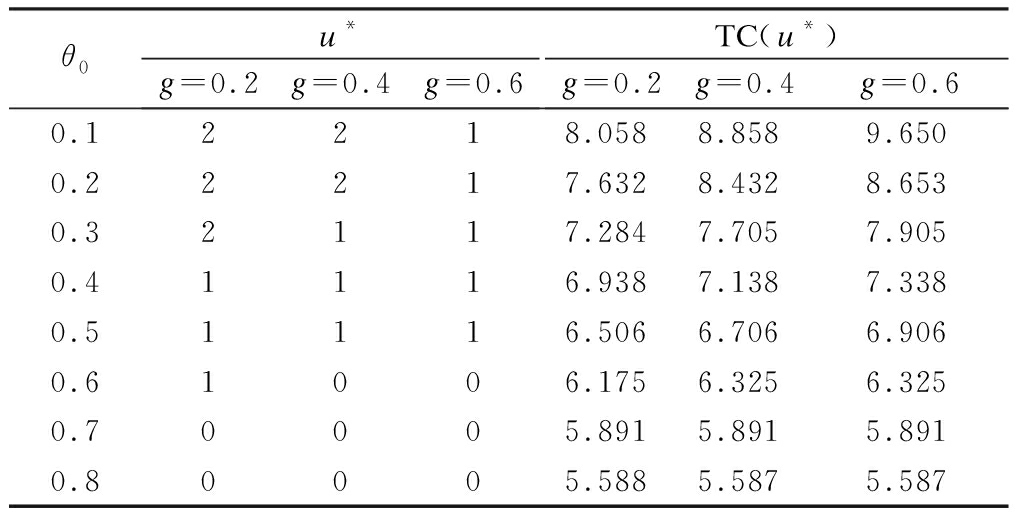
θ0u*g=0.2g=0.4g=0.6TC(u*)g=0.2g=0.4g=0.60.12218.0588.8589.6500.22217.6328.4328.6530.32117.2847.7057.9050.41116.9387.1387.3380.51116.5066.7066.9060.61006.1756.3256.3250.70005.8915.8915.8910.80005.5885.5875.587
3 Conclusion
This paper mainly investigates the investment decision optimization for delayed product differentiation. A flexible manufacturing system modeled as a continuous time Markov chain is considered. Two important queuing performance measures by using the matrix geometric method are computed. Furthermore, our study leads to three managerial recommendations. First, the manager should consider the initial OPP when making a decision to invest or disinvest in the process improvement. Secondly, the manager should focus more on impatient customers as the cost of customer order fulfillment delay can have different impacts on the investment decision. Finally, the manager should take a more holistic viewpoint by considering the value of the products and the cost directly associated with the investment decision, especially when attempting to launch a high volume of investment.
[1] Adler P S, Benner M, Brunner D J, et al. Perspectives on the productivity dilemma [J].Journal of Operations Management, 2009, 27(2): 99-113. DOI:10.1016/j.jom.2009.01.004.
[2] Lee H L, Tang C S. Modelling the costs and benefits of delayed product differentiation [J].Management Science, 1997, 43(1): 40-53. DOI:10.1287/mnsc.43.1.40.
[3] Perry J. Birthplace of the i3 [J].Automotive Manufacturing Solutions, 2014, 15(3): 12-14.
[4] Lee H L, Billington C, Carter B. Hewlett-Packard gains control of inventory and service through design for localization [J]. Interfaces, 1993, 23(4): 1-11. DOI:10.1287/inte.23.4.1.
[5] Jewkes E M, Alfa A S. A queueing model of delayed product differentiation [J]. European Journal of Operational Research, 2009, 199(3): 734-743. DOI:10.1016/j.ejor.2008.08.001.
[6] Pang R Y, Liu D C, Li Q, et al. Process flow reorder model based on cost control strategy[J]. Computer Integrated Manufacturing Systems, 2009, 15(7): 1286-1291,1316. (in Chinese)
[7] Zhang M, Cheng W M, Zhang Z Q, et al. Supply chain postponement strategy model for mass customization[J]. Journal of Southwest Jiaotong University, 2011, 46(6): 1055-1059. (in Chinese)
[8] Shao Z F, Zhang T, Lin Y J. TFT-LCD production strategy optimization[J]. Computer Integrated Manufacturing Systems, 2011, 17(5): 1064-1070. (in Chinese)
[9] Shan D W, Chen W, Yang Y X. Application of postponement strategy in apparel supply chain management[J]. Journal of Textile Research, 2016, 37(4): 153-159. DOI:10.13475/j.fzxb.20150302407. (in Chinese)
[10] Liu W H, Wu R Z, Liang Z C, et al. Decision model for the customer order decoupling point considering order insertion scheduling with capacity and time constraints in logistics service supply chain [J]. Applied Mathematical Modelling, 2018, 54:112-135. DOI:10.1016/j.apm.2017.09.027.
[11] Youssef K H, van Delft C, Dallery Y. Priority optimization and make-to-stock/make-to-order decision in multiproduct manufacturing systems [J]. International Transactions in Operational Research, 2018, 25(4): 1199-1219. DOI:10.1111/itor.12464.
[12] Lee H L. Effective inventory and service management through product and process redesign [J]. Operations Research, 1996, 44(1): 151-159. DOI:10.1287/opre.44.1.151.
[13] Su J C P, Chang Y L, Ferguson M. Evaluation of postponement structures to accommodate mass customization [J]. Journal of Operations Management, 2005, 23(3/4): 305-318. DOI:10.1016/j.jom.2004.10.016.
[14] Ngniatedema T, Fono L A, Mbondo G D. A delayed product customization cost model with supplier delivery performance [J]. European Journal of Operational Research, 2015, 243(1): 109-119. DOI:10.1016/j.ejor.2014.11.017.
[15] Neuts M F. Matrix-geometric solutions in stochastic models:An algorithmic approach[M]. Baltimore, USA: Johns Hopkins University Press, 1981.
[16] Dye C Y, Hsieh T P. An optimal replenishment policy for deteriorating items with effective investment in preservation technology [J]. European Journal of Operational Research, 2012, 218(1): 106-112. DOI:10.1016/j.ejor.2011.10.016.
[17] Desai P, Kekre S, Radhakrishnan S, et al. Product differentiation and commonality in design: Balancing revenue and cost drivers [J]. Management Science, 2001, 47(1): 37-51. DOI:10.1287/mnsc.47.1.37.10672.